Cotyledon adscendens
Cotyledon adscendens R.A Dyer
Family: Crassulaceae
Common names: climbing cotyledon, climbing pig’s ear, red-margined cotyledon (Eng.), rankplakkie (Afr.)
Introduction
A striking, evergreen, succulent shrublet, with vibrant orange-red, bell-shaped flowers and distinctive, fleshy leaves, native to the dune thickets of Eastern Cape.

Description
Description
Cotyledon adscendens is a perennial, slightly branched succulent that grows up to 2 m tall. It consists of upright to spreading branches bearing fleshy green leaves that are obovate to spatulate, flat, and slightly hollowed, measuring up to 60 mm long and 25 mm wide, and featuring reddish margins around the whole leaf.
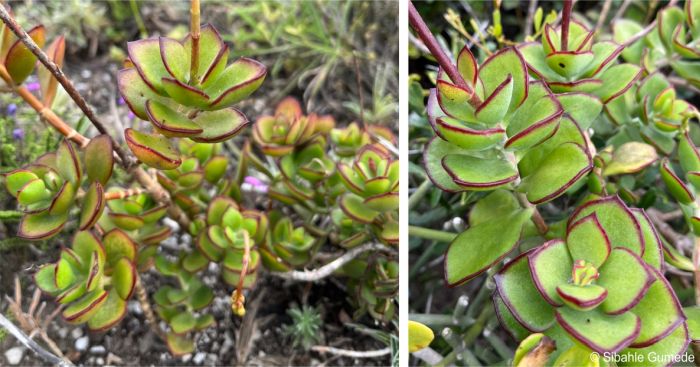
In spring and early summer (Oct.-Dec.), it produces a clustered inflorescence of nodding orange-red flowers, each up to 25 mm long and 10 mm in diameter, at the tip of a stalk that can grow up to 300 mm long.
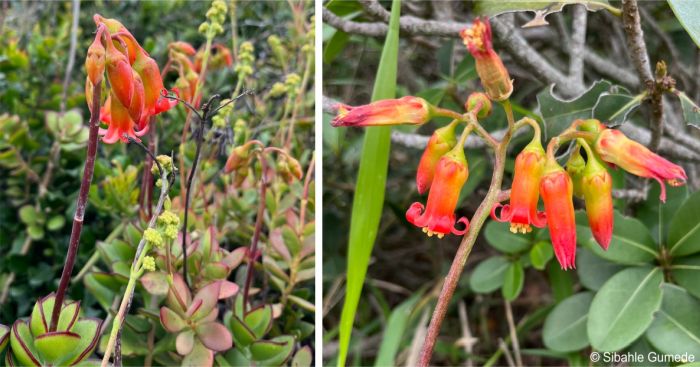
Cotyledon adscendens is quite similar to Cotyledon woodii, which is characterized by glabrous leaves and its notable, distinctive inforescence which is reduced to a single red bell-like flower hanging on a long stalk, positioned close to the upper leaf axil. These features differentiate it from Cotyledon adscendens.
Conservation Status
Status
Cotyledon adscendens is assessed as Endangered (EN) by the Red List of South African Plants. The species occurs over a small area and has a declining population. It faces several threats including habitat loss caused by urban development, where most of the remaining habitat has been earmarked for housing developments. Habitat degradation, the quality of its habitat, is also a factor because it is worsening due to invasive alien species which are competing with Cotyledon adscendens for resources, further threatening the survival of this species in its habitat. Conservation efforts for Cotyledon adscendens include propagation and cultivation in gardens and supporting its ex-situ conservation.
Distribution and habitat
Distribution description
Cotyledon adscendens is native to the Eastern Cape Province of South Africa, where it thrives in thicket vegetation behind coastal dunes, between Gqeberha and Coega. This succulent species prefers a warm climate and is not frost-tolerant. It grows in areas with well-draining soil and full sun to partial shade. The specific rainfall requirements for Cotyledon adscendens are not well-documented, but as a succulent, it is likely adapted to relatively low rainfall conditions.
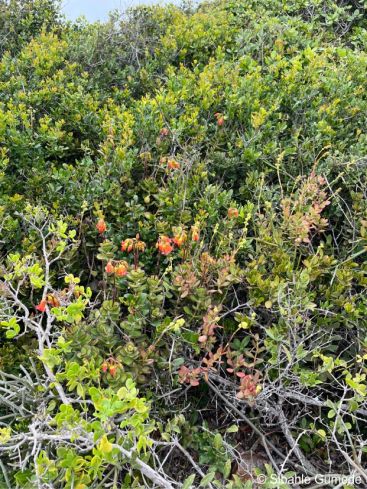
Derivation of name and historical aspects
History
The name of the genus Cotyledon is derived from the Greek word kotyledon or kotyle meaning ‘cupped’, ‘hollowed’ or ‘a cavity’, which refers to the rounded, cupped leaves typical of plants in this genus. The species name adscendens is derived from a Latin word meaning ‘climbing’ or ‘ascend’, which refers to its climbing growth habit which makes this species unique within the Cotyledon genus. This species is commonly known as the climbing cotyledon, referring to its scrambling growth habit.
Cotyledon adscendens was named by botanist Robert Allen Dyer in volume 27 of the publication Flowering Plants of Africa in 1949. Cotyledon adscendens is a member of the Crassulaceae, a family of succulent plants which consists of about 30 genera and 1 400 species in the world, with 5 genera in South Africa, Crassula, Kalanchoe, Cotyledon, Tylecodon and Adromischus, many of them well-known ornamentals. The species of this family prefer dry and rocky habitats all over the world, mostly in warm areas with South Africa and Mexico having highest diversity of Crassulaceae species. They are mostly perennials, playing an important role in economic development. The species from the Crassulaceae family are mostly famous for their ability to store water in their leaves and stems, making them drought resistant plants.
Cotyledon is a small genus within the Crassulaceae family consisting of 19 accepted species all of which occur in South Africa. They possess pendulous, tubular flowers with parts in fives, distinctive features which distinguish them from other members of their family. Also, cotyledons can differ widely in size, for instance, Cotyledon velutina can reach up to 3 m in height while Cotyledon tomentosa is only about 150 mm tall. They also stand out with their bright orange, red or yellow flowers and range of different leaf shapes and colours. One species, Cotyledon petiolaris, has short leaf petioles a which is a feature not often seen in the Cotyledon genus.
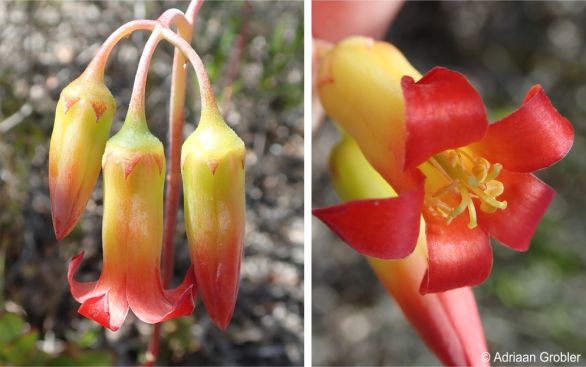
Ecology
Ecology
Cotyledon adscendens, is pollinated by birds. The flowers, which are tubular and often red to orange, are adapted to bird pollination. The Cotyledon adscendens is found growing in dune thickets and it is most important to note that dune thickets experience occasional fires, and as a result, species from such areas have become adapted to fires and developed the ability to survive fires by resprouting after being damaged by a fire. Cotyledon adscendens, as a succulent, may have high tolerance to fire due to its water storage tissues which could provide protection against heat damage.
Uses
Use
In gardens and parks, Cotyledon adscendens can be displayed for ornamental purposes. Its climbing habit allows it to be trained along fences or to form part of an informal hedge or screen. It is well-suited to water-wise gardens, ideal for rockeries, mixed beds, embankments and is suitable for containers. Also, Cotyledon adscendens is a is a toxic plant, especially if ingested by livestock.
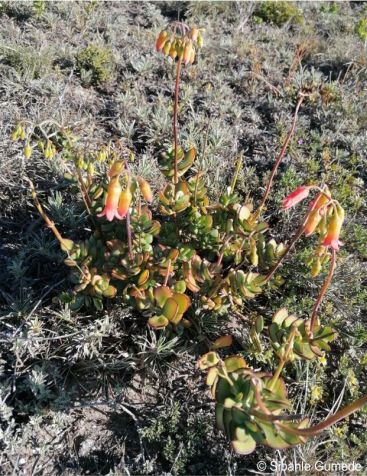
Growing Cotyledon adscendens
Grow
This is a plant that is easy to grow. Cotyledon adscendens is easily propagated through cuttings and seeds. Sow seeds in a free draining, sandy sowing medium, while keeping the seeds close to the surface as the seeds are very small and burying them too deeply may cause them to rot. Keep the sown seeds in a warm sunny location after sowing as they are naturally adapted to bright and sunny conditions. Keep them moist but not wet, as this is a plant that is adapted to dry conditions, and when germinated wait until the medium dries out before watering again, as too much water may cause rot.
Make cuttings during spring and summer, when the plant will be in its active growth period, to improve chances of rooting. Plant the cuttings in a pot filled with free-draining, gritty sand, or a mixture of sand and well-rotted compost. Thereafter, keep the propagated cuttings moist and place them in a spot that has free air circulation and where they will be exposed to sunny conditions, or in a greenhouse until they root. When watering, keep water off the leaves as that may cause fungal infections.
The genus Cotyledon is associated with mealy bugs and vine weevils, if the plants are infested, these can be best treated with the use of a systematic insecticides.
References
- Bredenkamp, C. 2019. A flora of the Eastern Cape Province. Strelitzia 41. South African National Biodiversity Institute, Pretoria.
- Grobler, A. 2018-Dec. Observations of Cotyledon adscendens, Coega, EC. iNaturalist. Online. https://www.inaturalist.org/observations/28558764.
- Gumede, S. 2020-Nov. Observations of Cotyledon adscendens, Gqeberha, EC. iNaturalist. Online. https://www.inaturalist.org/observations/ 71865944 & 252415803.
- Gumede, S. 2024-Nov. Observation of Cotyledon adscendens, Gqeberha, EC. iNaturalist. Online. https://www.inaturalist.org/observations/252410804.
- Hodgkiss, R.J. 2023. The Cotyledon Page. The Succulent Plant Page. Online. https://succulent-plant.com/families/crassulaceae/cotyledon.html.
- JSTOR Global Plants. Cotyledon adscendensCompilation. https://plants.jstor.org/compilation/cotyledon.adscendens. Accessed 6 May 2025.
- Koekemoer, M., Steyn, H.M. & Bester, S.P. 2015. Guide to Plant Families of southern Africa. Strelitzia 31. 2nd ed., 2nd print. South African National Biodiversity Institute, Pretoria, South Africa.
- Mort, M.E., Levsen, N., Randle, C.P., Van Jaarsveld, E. & Palmer, A. 2005. Phylogenetics and diversification of Cotyledon (Crassulaceae) inferred from nuclear and chloroplast DNA sequence data. American Journal of Botany 92(7):1170–1176.
- Ntenga, C.S., Shange, N. 2023. Cotyledon velutina Hook.f. (Crassulaceae). PlantZAfrica. Online. https://pza.sanbi.org/cotyledon-velutina.
- Plants of the World Online. Cotyledon. L. https://powo.science.kew.org/taxon/urn:lsid:ipni.org:names:30005010-2. Accessed 20 June 2025.
- Raimondo, D. 2007. Cotyledon adscendens R.A.Dyer. National Assessment: Red List of South African Plants. https://redlist.sanbi.org/species.php?species=3834-1.
- SANBI. Kirstenbosch Conservatory: Leslie Hill Stone Plant House https://www.sanbi.org/gardens/kirstenboch/seasons/botanical-society-conservatory/kirstenbosch-conservatory-leslie-hill-stone-plant-house/. Accessed 06/05/25.
- Toelken, H.R. 1985. Crassula. In Flora of southern Africa 14: 1–229.
- Van Jaarsveld, E. 2016. Cotyledon petiolaris Van Jaarsv. (Crassulaceae). PlantZAfrica. Online. https://pza.sanbi.org/cotyledon-petiolaris.
- WFO Plant List. Cotyledon adscendens Dyer. https://wfoplantlist.org/taxon/wfo-0000623657-2024-12?page=1. Accessed 6 May 2025.
- World of Succulents. Cotyledon adscendens. https://worldofsucculents.com/cotyledon-adscendens/. Accessed 6 May 2025.
Credits
Mlondi Skhosana and Charlotte Ntenga
KwaZulu-Natal National Botanical Garden
June 2025
Acknowledgements: images by Sibahle Gumede and Adriaan Grobler from their observations posted on iNaturalist.
Plant Attributes:
Plant Type: Succulent
SA Distribution: Eastern Cape
Soil type: Sandy
Flowering season: Spring, Early Summer, Winter
PH: Acid, Neutral
Flower colour: Red, Orange
Aspect: Full Sun
Gardening skill: Easy
Special Features:
Horticultural zones
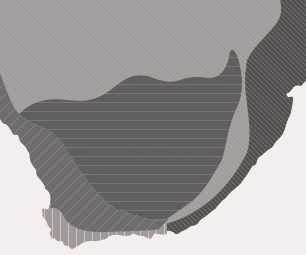






Rate this article
Article well written and informative
Rate this plant
Is this an interesting plant?
Login to add your Comment
Back to topNot registered yet? Click here to register.